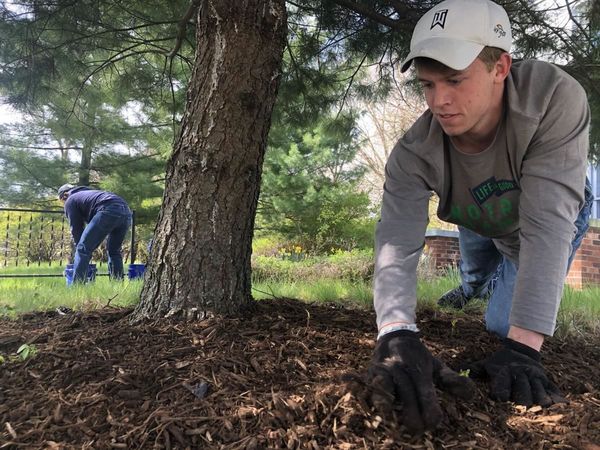
SOUTH BEND — A group of Notre Dame students and researchers on Saturday continued their efforts to tackle South Bend’s lead poisoning problem, and they want residents to know there’s more money than ever available to help.
In what they dubbed “Mulch Madness,” they spent about five hours spreading mulch over exposed soil in the yards of 40 participating homes in the historic Monroe Park neighborhood southeast of the downtown. They also used a free test kit the university has developed to collect paint chip and dust samples from the homes’ interiors for lab analysis.
Biological Sciences Associate Professor Heidi Beidinger-Burnett, co-founder of the university’s Lead Innovation Team, said the city has about $3 million in federal money, and the county has another $1 million, for income-eligible residents to have their interior lead paint risk assessed and eliminated, money that didn’t exist in 2017. That was when alarms sounded after the Indiana Department of Health told the St. Joseph County Department of Health that children had shown unusually high blood lead levels from 2005 to 2015 in Census Tract 6 in the city’s Near Northwest neighborhood.
Unlike lead poisoning resulting from water pipes in Flint, Mich. and East Chicago, Ind., South Bend’s lead problem comes from paint chips and dust in older homes, since the United States didn’t outlaw lead-based paint until 1978 and the city has so many older homes.
Beidinger-Burnett, also a county health board member, said parents living in older homes don’t have to wait for the university’s test kit or the city or county’s assessment and remediation efforts.
“Just once a week taking a regular old cotton rag that’s a little bit damp and wiping down all the horizontal surfaces will eliminate the bulk of the leaded dust,” she said. “Even just having that knowledge and that information will reduce the exposure for any kids that are living in the house.”
Frequent dusting in older homes is especially important near points of friction with paint on walls and trim, such as around doors and windows.
“It used to be that we all thought that kids were just eating the paint chips. True enough. But the fact is that the greater risk is actually through the dust.”
Chronic exposure to even low levels of leaded dust, such as a toddler crawling in it, interrupts with brain and physical development.
“Lead affects every single organ and system in the body,” Beidinger-Burnett said. “It’s probably one of the most devastating things that you can ingest and you have no idea because it doesn’t smell, you can’t see it.”
In children its symptoms can be mistaken for attention deficit disorder, she said.
“Lead poisoning has been associated with lower student achievement, higher dropout rates, lower lifetime earnings, and higher criminality and incarceration.”
Rick Tribble allowed the team to take dust and paint chip samples from his Carroll Street home, which he said was built in 1905 or 1910.
Tribble said the family moved into the house in 1994 and over the years he tried to scrape off paint where it looked like it might start chipping off. He said before Saturday he hadn’t known that dust poses a risk.
If the Notre Dame lab results indicate he has a problem, Tribble said he would seek help addressing it from the city.
“Why not know?” said Tribble, whose three daughters, all in their 20s, grew up and still live in the house with him. “You know it has to (have lead).”
Chemical engineering and theology sophomore Cameron Taylor was one of about 80 students who came out to spread mulch that was donated by the city and transported by university trucks. He said last year Neuroscience and Behavior junior Kyle Moon started “Service Saturdays,” in which students would donate their time and labor for community projects.
“We worked at (nearby) Dismas House last year and there was just paint chips falling that were massive and obviously filled with lead, so when (Moon) announced this project, I thought this is exactly what the neighborhood needs,” Taylor said. “We’re really excited to help because we haven’t been in the community as much because of the pandemic.”
This story was originally published by Jeff Parrott South Bend Tribune on April 18, 2021.